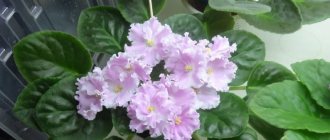In Russia, in a relatively short period of time, a strong school of violet breeding has developed with its own traditions and extensive range of varieties.
They are presented within the country and at world forums of flower growers by experienced, renowned and just beginning masters in creating Saintpaulia varieties.
The violets of Russian breeders
are different :
- Bright decorative images;
- Stable varietal characteristics;
- The beauty of names;
- And ease of care.
They are widespread not only in the collections of Russian flower growers, but also among violet growers around the world .
Among the varieties of domestic lines, one can imagine the violet “Pink Watercolor” as an example of a successful combination of a dark variegated rosette and spectacular pink flowers.
Violet, description and photo Pink Watercolor (K. Morev)
Violets from breeders of the CIS countries - “R”.
Pink Watercolor (K. Morev).
Pink Watercolor, Rozovaia Akvarel (K. Morev).
Very large double and semi-double soft pink stars with a white “blurry” center, a soft ash pink spot in the center of each petal and a white wavy lace border.
A neat exhibition variegated leaf, green leaves with a thin white edge. Standard. The variegation of this variety is weakly expressed, the leaf is bordered by a white stripe along the edge. The rosette is large, but neat, although it hugs the pot.
Large white flowers with clear strokes of pink. The center is blurry, white, the edges look like a lacy white border. A flower with a very wavy edge. Sometimes this Saintpaulia is almost completely white, sometimes, on the contrary, it is very bright.
Flowering is very abundant and long lasting with an interval of 2-4 months. The flowers are really large, 5-7 cm, each lasts from 3 to 5 weeks.
The size of the flowers also depends on the air temperature; the cooler the room, the greater the difference between day and night temperatures, the larger and brighter the flowers.
Hardy and resistant variety. The variety is very easy to propagate and care for, very prolific, and always repeats itself from the leaf. With good lighting, the flowers will be really large. It does not like it when the leaves are removed; flowering is often delayed or becomes less abundant. Afraid of overwatering, watering very carefully, prone to fungal infections.
Watercolor (Latin aqua - water), paints (usually with vegetable glue) diluted with water, as well as painting with these paints. Its main qualities are: the transparency of the paints, through which the tone and texture of the base (mainly paper, rarely ivory silk) shine through, and the purity of color.
Do you know that…?
Reproduction of variegated violets. If it is a leaf from a variegated Saintpaulia variety, it should have quite a lot of green pigment on it. To propagate variegated violets, it is not recommended to use old or too young leaves. For planting, you need to choose the greenest leaves, where the variegation is expressed as little as possible; choose the greenest leaves that are possible. Leaf cuttings of variegated leaves with less than 30% green surface will either die during the rooting process, or do not produce offspring for a long time and then die anyway. 50% green is even better. Variegated violets are, perhaps, the only species (not counting chimeras) that are best purchased as children rather than cuttings. And if by cuttings, then at least two at once.
Before you buy the violets listed below, carefully read the forums about their behavior on the windowsill. Many of them are very beautiful flowers. However, these can be large rosettes with large and fragile leaves, with leaves rising up or hugging the pot, forming many stepsons that interfere with the formation of a neat rosette, pulling the stem up and growing into a Christmas tree, bending the trunk, rare flowering with long breaks, fallen flowers or they last little and quickly wither, very long and recumbent peduncles, the color of the flower fades quickly, they do not like bright lighting on the windowsill, they are afraid of the slightest drying out or waterlogging, a large percentage of them go into sports or darken the flower.
Display of life phases
The course of life processes in its main direction converges with the manifestations of similar life phases of most varieties of the genus.
This makes it possible for novice collectors of tropical beauties to calculate schedules and regimes for caring for violets using a standard pattern with minor allowances for nuances.
Specificity of room development
Experienced flower growers consider the violet variety to be ideal for maintaining indoor culture in the microclimate ; it is especially suitable for beginners in the “Saint Paul” hobby as the first specimen of an exotic collection thanks to:
- Resistance to adverse events and endurance in case of minor maintenance violations;
- Easy care techniques;
- Simple methods of reproduction and an abundance of children;
- Lush and decorative flowering.
When cultivating violets indoors, special attention should be paid to watering regimes , in particular to the amount of water the plant receives. This will prevent parts of Saintpaulia from rotting due to the accumulation of liquid in the flowerpot, to which the variety is largely susceptible.
During the process of forming a rosette, the leaves of a specimen can often curl down, trying to hug the flowerpot, which :
- Contradicts the author's description of the variety;
- And it spoils the decorative impression of the violet.
A rosette corset can help cope with this negative phenomenon .
Education of an adult specimen
The onset of the phase of the first flowering and maturation of the violet occurs with the leaf petioles method approximately eight months after the formation of the rudiments of the children . If a violet specimen is obtained from an axillary shoot from an adult plant, then the period of maturation will be noticeably reduced.
Peculiarity of reproduction
The process of vegetative propagation of varietal violets almost completely copies this life phase in most varieties of Saintpaulia - to obtain young specimens, flower growers have only two methods :
- By carefully separating the stepsons that have grown on it from an adult violet , and rooting them in due time in their own flowerpots;
- Having formed a baby on a leaf petiole , specially prepared for this purpose, followed by rooting.
The method of mandatory rejuvenation of adult violets ensures that all the characteristics of the variety remain intact.
The violet does not like it when almost all the leaves are removed from it for the suffering - after such a barbaric procedure, Saintpaulia becomes very sick and has difficulty recovering.
Effect of temperature on flowers
Blooming violets exhibit a certain dependence on changes in temperature indicators:
- When flowering in cool conditions, the intensity of the pink color of the flowers is lower, the longer the exposure to low temperatures occurs - the color can turn into a completely white color;
- The higher the temperature in the room with a violet in bloom, the brighter its flowers will be;
- A decrease in the temperature in the room leads to a change in the size of the flower: the colder it is, the larger the diameter of the flower;
- Low temperatures bring out the brightness of the edge band of the petals.
Varietal violets must be protected from changes and sudden changes in temperature, as well as from drafts.
Pedicel structure
The variety immediately has strong, optimally sized peduncles that easily support heavy flower caps in a straight position, preventing them from spreading out on the leaf plates of the rosette.
Flowering type model
At first, the variety blooms with single flowers , but gradually gains strength and forms lush caps.
The violet will be grateful for a little help in preparing for powerful cap blooms - just remove the first buds before they dissolve.
Lifespan of an individual flower
Saintpaulia Pink Watercolor blooms for almost 1.5 months.
During flowering, a violet can maintain freshness and general decorativeness for a long time , while each individual corolla can live up to five weeks.
Pink Watercolor, K. Morev
Found a mistake? Report it: 1) Select the error with the mouse 2) Press CTRL+Enter. Read more.
Violet Pink Watercolor , K. Morev _
Large semi-double soft pink flowers with a white “blurry” center and a white lace border. Variegated leaf.
Contents in room culture
Violet Moreva Pink Watercolor, in order to preserve the spectacular decorative structure of its flowers and maintain the general level of health in the microclimate of the room, the collection will be grateful for the regular implementation of the usual care regimens , adjusted for small nuances of keeping variegated leaves:
- It is best to display violets ; the northern direction of the window necessarily requires additional light from the artificial spectrum, and the southern window always predetermines the creation of a small shadow for the violet;
- Watering is carried out in small portions, and always after light preliminary drying of the upper tier of the substrate;
- The appearance of the violet will indicate the need to apply mineral fertilizers
- Lighting needs to be long-lasting, natural, diffuse;
- Temperature - within +18 + 20°C without jumps or changes;
- The soil in the flowerpot is rich, well aerated, and permeable;
with a volumetric drainage system; Saintpaulia requires proper care. - Transplantation is best done by transshipment, except in unforeseen cases;
- The humidity should be slightly increased without spraying the violet itself.
Properties
Name
- Original: Pink Watercolor
Registration
- Selection: Morev K.
- Year: 2006
Socket
- Socket type: standard
Flower
- Flower size, up to: 6 cm
- Terry size: semi-double, terry
- Main Color: Pink and White
- Color type: two-tone
- Border: light
- Other features: wavy flower edges
Foliage
- foliage color: dark green
- foliage type: simple
- foliage shape: pointed
- leaf edge: jagged edge
- variegation: bordering (Tommy Lowe)
Peculiarities
A very neat variegated leaf.
The leaf is dark, and the light bordering white stripe on the edge of the leaf gives the foliage a special charm and makes each leaf lighter. Pink Watercolor is a bright beauty, each flower is wavy, like an airy summer dress that the wind blows in a dance. Large white flowers with clear strokes of pink, as if an artist painted each flower with watercolors.
This variety has a long flowering period.
Light is important in care, then the flowers will be really large. The size of the flowers also depends on the air temperature; the cooler the room, the greater the difference between day and night temperatures, the larger and brighter the flowers. The variety really does not like when the leaves are removed; flowering is often delayed or becomes less abundant.
Conditions for growing violets at home
For full development, Saintpaulias need certain conditions that will be as close to natural as possible.
Of particular importance are:
- lighting quality;
- temperature;
- humidity.
Placement and lighting
Violets need a lot of diffused light and high-quality shading from direct sunlight. Incorrect light conditions worsen the quality of flowering, and may even cause its absence. The optimal distance to the light source should be 30–40 cm. Violets need a long daylight hours—10–12 hours.
Important! Violets can be freely placed on wide window sills, even on the sunny side, if tall cacti and palm trees are located closer to the glass. Tall plants will create sufficient shade from direct sunlight, and you will be able to organize a beautiful exotic corner right in the apartment.
The best placement option is a wide window sill on the east or west side. It is important to ensure that plants do not come into contact with glass, as they cannot tolerate cold or overheating. If there is no such place in the house, you can place the plants on special racks in any part of the apartment, providing them with lighting from a phytolamp. The distance from the outlet to the phytolamp should be within 20–30 cm.
Temperature and humidity
The optimal temperature for year-round cultivation of Saintpaulia is +18…+20°C. With this mode, you can achieve long-lasting double flowering. In the summer months, violets feel good at a temperature of +28°C, but bloom less profusely. In winter, a short-term decrease in night temperatures to +12°C is permissible, but not more than 2–3 days in a row. Otherwise, the plants may die from freezing.
Air humidity should be 50–75%. If necessary, the space around the plant can be moistened with a spray bottle, but this must be done with great care. A good option is to place violets in close proximity to plants that actively evaporate moisture: this way it will be possible to create a natural symbiosis, as in natural conditions.
Pink watercolor
Saintpaulia of this delicate color was not created just like that. From time immemorial, pink has symbolized harmony between passion and innocence; it is the color of contradiction in love, feelings and femininity. That is why flowers of this shade have always been highly valued. Pink watercolor is a uniquely beautiful variety, with very large flowers (double) of pale pink color. The center is blurry, white, the edges look like a lacy white border. This is the K. Moreva variety. It is called graceful variegated leaf.
Each leaf is bordered by a white stripe along the edge, although it itself is dark. This makes the plant even more delicate and original. The airy waviness of the petals appeals to many collectors. The name is associated with the peculiarity of the color: pink strokes are visible on the white flowers, as if painted with an artist’s brush. Sometimes this Saintpaulia is almost completely white, sometimes, on the contrary, it is very bright.
It blooms for a very long time, and in excellent light it will produce large flowers more than six centimeters in diameter. Their value is also affected by the ambient temperature. Pink watercolor likes cool, and the brightness increases as the difference between the air temperature at night and day increases.
Removing leaves is not recommended: this procedure can delay the onset of flowering for a long time or make it less lush, abundant and beautiful. If you strictly adhere to all the rules of caring for the plant, then this Saintpaulia will be a lush, graceful and elegant beauty in the owner’s collection.
Varieties by border color
In order to easily navigate the types of violets, breeders divide them into three main groups. The collection group is intended for breeding unusual varieties; these violets most often take part in exhibitions and are demanding of care.
The industrial group is grown in large quantities on huge plantations, they are put up for sale in large quantities and are most often intended for decorating premises. These varieties bloom for a long time, but at the same time have a normal appearance. But the third group - variegated violets - is characterized by a variety of colors, bright colors and the presence of edging. Initially, they were also inconspicuous in appearance, but later breeders worked hard on this group and the plants acquired double flowers of variegated colors.
White border
Saintpaulias, which have a white border, are distinguished by small inflorescences that somewhat resemble stars. The leaves of this variety have a rich green color and a heart-shaped shape.
- A striking representative of this class is the Rosemary violet. In addition to the white edging, the leaves have an amazing combination of pink strokes and variegated blue drops.
- Violet Fire moths are the most unusual type of double violet. Its peculiarity lies in the change in color of the border: most of the day it is white, but when the flower is fully opened, the shade changes to pink.
- Violet Magic of Love is distinguished by its deep purple color, sometimes with a beetroot tint, due to this the white border stands out well and emphasizes the beauty of the plant.
- Violet Macho has purple-black flowers and a semi-double structure. The flower is like a chameleon: in daylight it is purple, in artificial light it is burgundy. Its leaves are very large and grow upward, because of this the flowers are located close to each other and periodically need help.
- Violet Beautiful Creole is another unusual flower. Its double petal is very large in size and the white border sometimes takes on a light green tint. The flower itself is a heavenly shade with a burgundy stem.
Green border
Violets of this variety are slightly finicky to care for and do not forgive mistakes. Natural light is their main requirement for fruitful flowering.
- Vodyanoy is the most beautiful representative of this variety. The bloom resembles a woman's lilac skirt with a lightened green border. The buds open slowly and last for a month. Usually this plant does not have many inflorescences, but they are strong and lush.
- Violet Winter Smiles is distinguished by rich double blooms of delicate pink color with green fringe. In this case, the edging will retain its color as long as it is cool, but in the heat it will change to white.
- Green's violet is considered a hybrid with fluffy double white flowers that hang from the pot. It blooms very slowly, but blooms for a long time, gradually the green border disappears, and the flower becomes monochromatic.
Lilac border
An easy-to-care type of violet, suitable for beginners. The leaves are round and regular in shape, bloom profusely and often.
- The delicate violet Wind Rose will delight everyone's eyes. It has lush double flowers, and the edges are corrugated lilac or pale pink. The size of such flowers is small, but on each peduncle usually several flowers appear at once, collected in a pink bouquet.
- Aphrodite has not just a lilac border, but also spots of the same color throughout the flower. At elevated temperatures it can turn bright lilac or even purple. It blooms very profusely and does not require much care.
- Helios violet is the most unpretentious and frost-resistant. Ideal for decorating balconies and flower beds. It has a pink color with a slight lilac edge, but the leaves are dark green.
Pink Panther
Saintpaulia variety Pink Panther belongs to the selection of K. Morev. Panther has large flowers, light pink in color, with a large white edge. The leaves are not dark, but not light either, scalloped, slightly pointed.
Some features of caring for violets of the Panther variety:
- If the rosette is exposed to excessive light, the color may become more pink, “floating” onto the white border and making the color generally more washed out;
- Also, a common problem when growing the Panther variety is too many leaves - this is often also related to lighting;
- During the first flowering, there are often no iridescent shades observed - the petals are completely pink;
- Leaves become denser when exposed to excess light;
- The wait for flowers may be delayed - the Panther is not a fast subspecies in this regard.
Often, collectors grow two varieties together: Saintpaulia Blue Mist and Panther. They are similar in foliage shape, look good next to each other, and the rules for caring for them are very similar. They cannot be overheated or overexposed, but otherwise the Panther is not at all capricious, according to reviews from amateurs.
Transplant rules, rejuvenation
Replanting is an excellent reason to rejuvenate the plant. They try to carry out the transplant procedure every 1-2 years. Ideally - every spring. If you leave a violet in old soil for more than 2 years:
- It will stop blooming profusely;
- The foliage will fade.
Violets are usually transplanted in March. The size of the pot does not change. The main task of replanting is to stimulate the growth of young roots; they will provide water and nutrition for new leaves and peduncles.
Transplant rules:
- It is better not to water the violet before transplanting. Dried soil easily falls off the roots and will not damage them;
- Carefully remove the roots, free them from most of the soil;
- Cut off old, diseased roots and leaves;
- Place the roots in new soil, cover with soil up to the leaves;
- Water the flower and add soil.
Pink marshmallow
Violets of this variety are distinguished by variegated rosettes, lush flowers, double appearance, and very bright (light crimson) color of the petals. The species was bred by Lebetskaya. It is quite rare, but very beautiful. Terry stars look like a plentiful, lush cap above the leaves. The leaves are even, variegated - with a delicate white border along the edge of the dark green leaf. One flower reaches 5-6 centimeters, the whole plant looks compact.
Zephyr has very strong peduncles that stand upright. The flowers are light when they first bloom and darken over time. The maximum diameter is six and a half centimeters. Saintpaulia of this variety looks classic, without play or multicolor, and the variegation of the leaves adds elegance to it.
Young foliage can be very light. In general, Zephyr can be quite different under different conditions. Brightness is primarily affected by lighting, which is why Marshmallow often turns out pale and tender. These flowers look more like small roses than violets. Zephyr blooms a lot of foliage, but it does not interfere with the growth of flowers, but, on the contrary, emphasizes the colors. In the first flowering, doubleness may not appear. Saturation is added as one blooms - from beginning to end.
Plant care rules
This flower feels most comfortable in well-lit areas with fertile soil. In shaded places, the bush can grow fully, but the abundance of flowering will decrease, and with excess moisture there is a danger of rotting.
Watering for fragrant violets is not a necessary procedure, because the bush survives even in drought, but without moisture, flowering will be very poor or will not occur at all, and the risk of damage by spider mites also increases. Irrigate the soil only when necessary, avoiding the appearance of puddles.
Feeding is carried out during the period of active growth, if desired by the owner. It is recommended to use mineral fertilizers, since the plant reacts extremely negatively to the application of fresh organic fertilizers.
Trim the shoots if necessary, removing rotten, dried and excess parts. At the same time, you can propagate the bush using the vegetative method. To do this, the healthy part of the stem-root is removed from the mother plant.
When replanting, it is important to minimally damage the root system, given the placement of the main root on the surface of the soil, it is recommended to cut the bush before digging it up (if necessary or desired). To rejuvenate an old individual, it is also shorn, leaving a rather small young ponytail.
To rejuvenate the old individual, it is also shaved, leaving a rather small young ponytail.
Pink Dalmatian
Saintpaulia variety Pink Dalmatian was bred by breeder Korshunova. This incredibly interesting color – lilac-pinkish flowers with a contrasting fantasy pattern in the form of purple or lilac-raspberry spots on double petals – gained popularity among collectors very quickly.
The foliage of the Dalmatian is rich, the leaves are simple, even and neat. The dark color is emphasized by the brightness of the flowers. Sports of this subspecies sometimes turn out to be contrasting, white and purple, but also very beautiful.
The fantasy of a drawing can be difficult to convey to children. But with proper transplants and seating arrangements, no problems arise. Elegant flowers decorate the collection, distinguished by intricate petal patterns. Fantasy flowers are not only dark lilac, but even eggplant. The only thing this variety lacks is variegation. Otherwise, this Saintpaulia is very good both in care and in appearance.
Saintpaulia in different shades of pink is an original flower that stands out brightly among many others. This is probably why every violet lover’s collection includes at least one of the above subspecies.
Plant diseases and pests
The main problem that gardeners face when breeding violets is the lack of flowering.
The problem may be caused by:
- improper care, which is quite easily corrected;
- diseases of various etiologies;
- pests.
Main diseases of Saintpaulia:
- Root and foliage rot - leaves lose turgor, the rosette changes color, petioles and leaves begin to wither, becoming watery. The solution to the problem should be quick, removing all damaged parts and rooting the remaining healthy part. To prevent the re-development of rot, before rooting, the plants are treated with ash with Fundazol (1:1 ratio) - irrigated or dusted with a dry mixture. The same composition is also used for preventive purposes during transplantation.
- Powdery mildew is caused by fungal spores that progress with high humidity and on weakened plants. Eliminated by complete removal of damaged parts and treatment with Fundazol according to the instructions.
- Fusarium is another fungal disease. There is no effective treatment for it, so it is better to immediately destroy such a specimen along with the soil, and treat the remaining plants next to it with “Fundazol” mixed with wood ash (1:1 ratio).
- Late blight - manifests itself as brown drying spots and loss of turgor. Healthy parts of the plant must be urgently separated and rooting attempted, and the affected parts of the plant must be disposed of along with the soil. All nearby specimens need urgent treatment, as with fusarium.
- Viral diseases cannot be treated. Plants are completely destroyed along with the soil.
Popular articles Weeping spruce Inversa
Pests of violets:
- Cyclamen mite - diseased plants are first isolated, the affected parts are removed and the sections are treated with wood ash. Treatment with Fitoverm is also carried out according to the instructions 2-3 times.
- Aphids - eliminated using a solution of tobacco dust. The liquid is sprayed over the leaf and used instead of water for top watering.
- Thrips - eliminated using liquid "Aktara" (add 1-2 drops of the substance to 3 liters of water), treat the leaves, peduncles and soil.
- Mealybug - eliminated in the same way as aphids.
- Sciarides - eliminated with the help of "Aktara", the proportions are the same as for thrips.
Prevention of diseases and pests:
- precise control of soil moisture and temperature conditions;
- timely application of fertilizers according to the age characteristics of plants;
- preventive tillage of the soil with a mixture of ash and Fundazol 1–2 times a year.
Important! When buying new violets for a month, they definitely need to organize a quarantine zone in which there will be no other plants already available at home. Violet variety Pink Watercolor is attractive with its unusual flowers
To achieve flowering from it up to 10 months a year, you must follow all the above rules
Violet variety Pink Watercolor is attractive with its unusual flowers. To achieve flowering from it up to 10 months a year, you must follow all the above rules.











